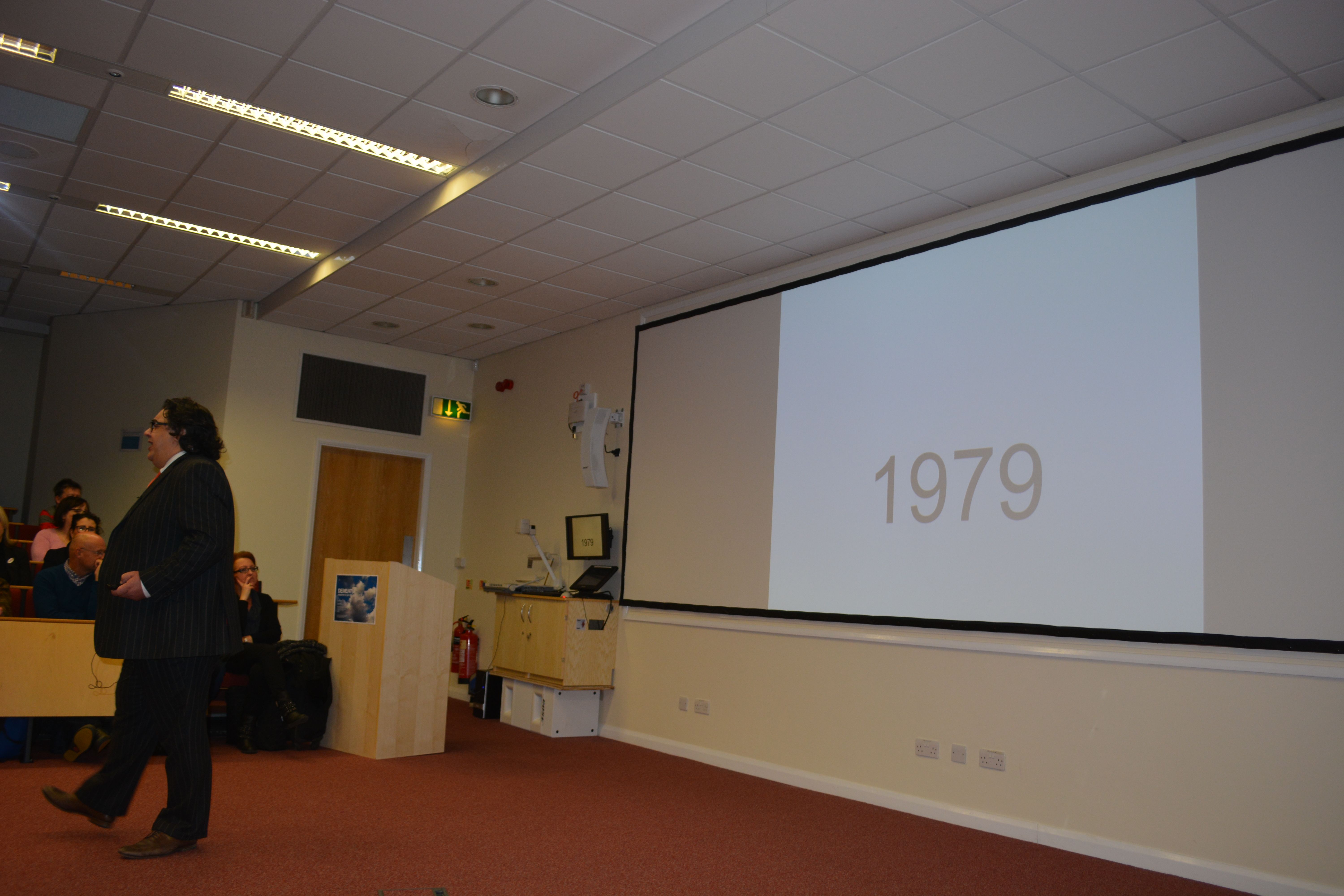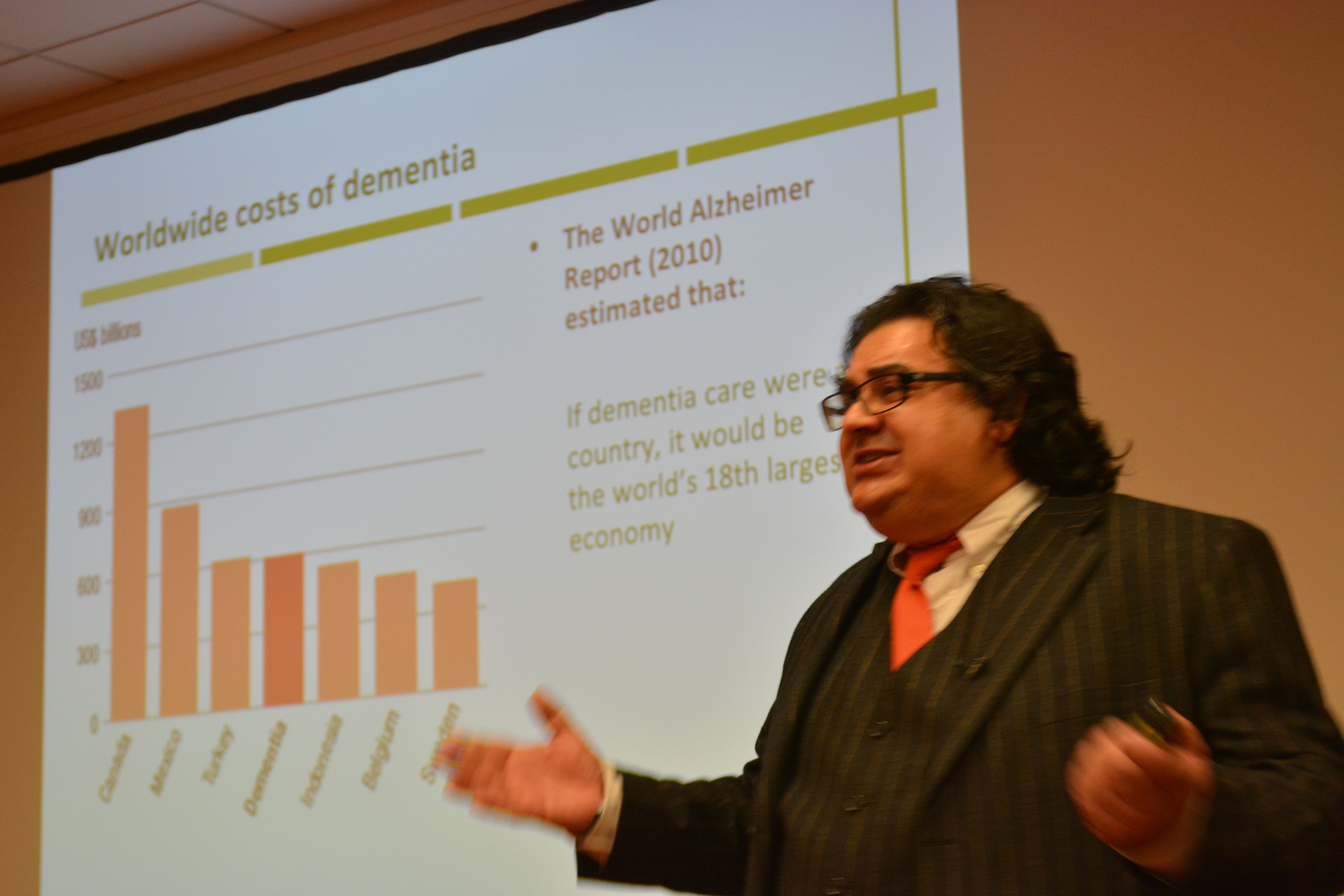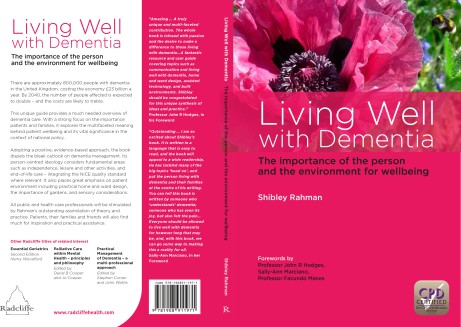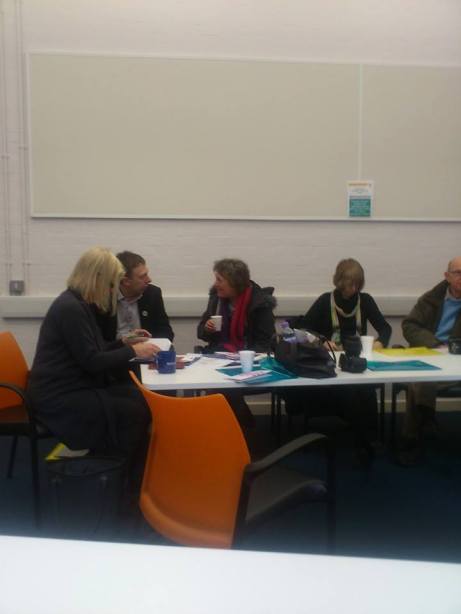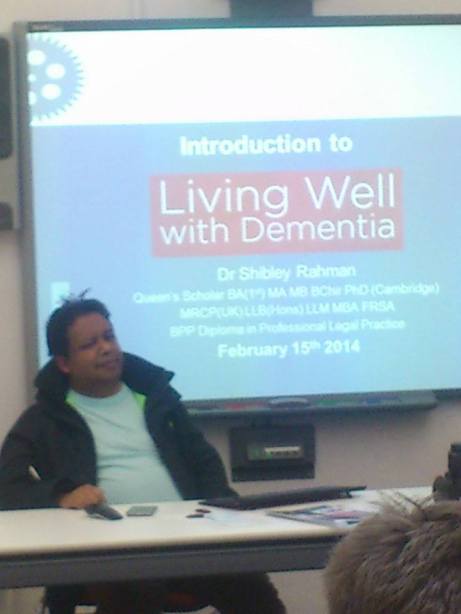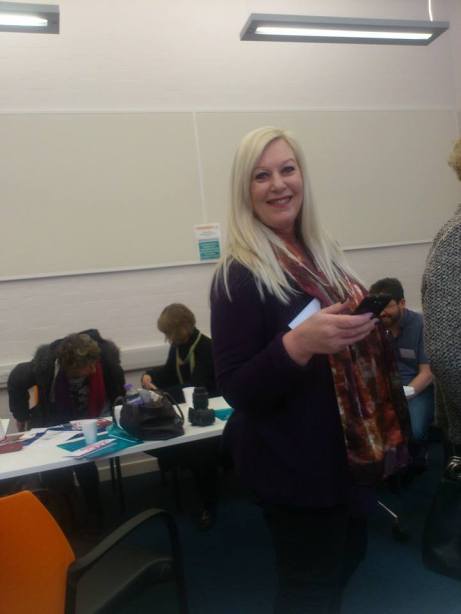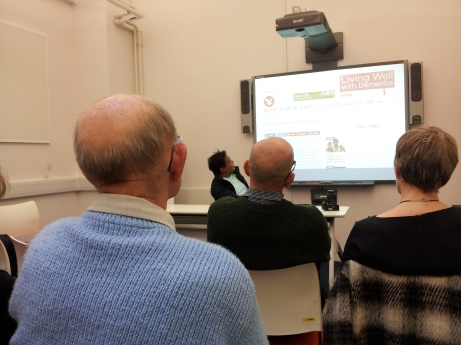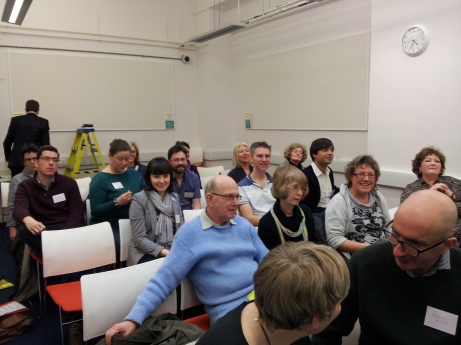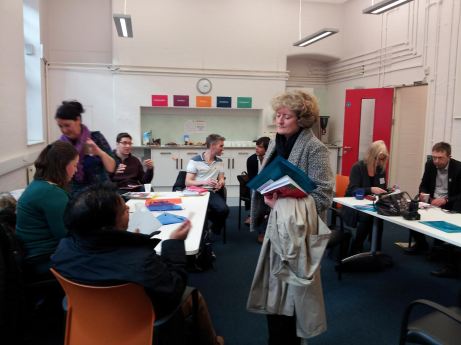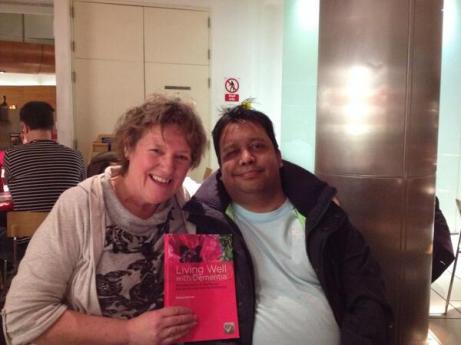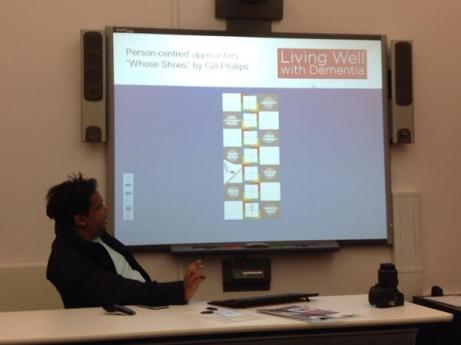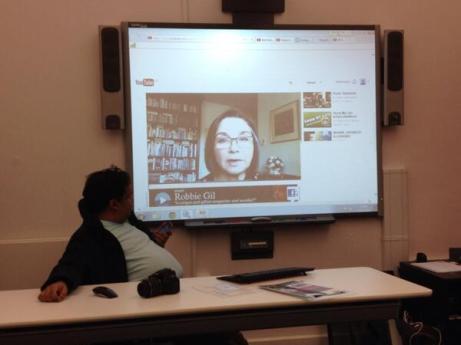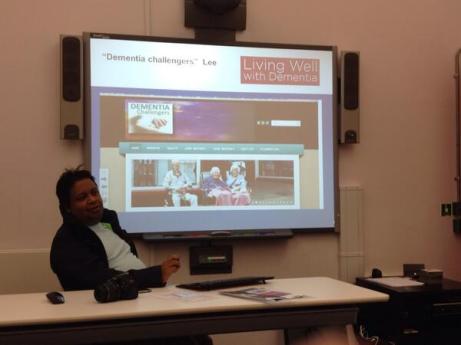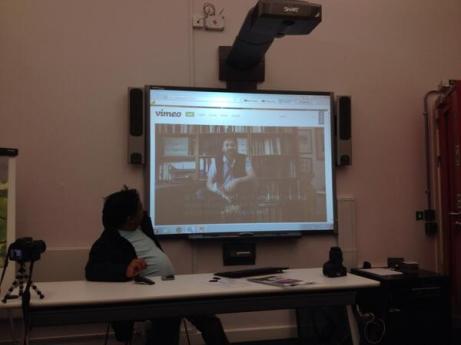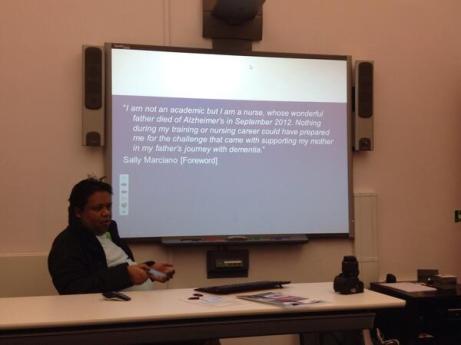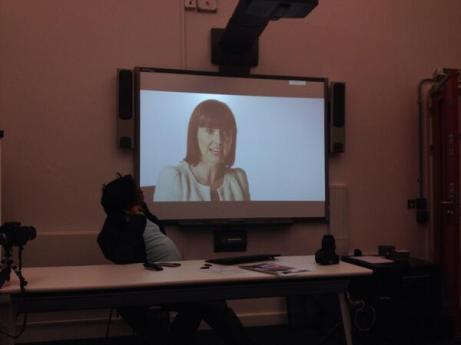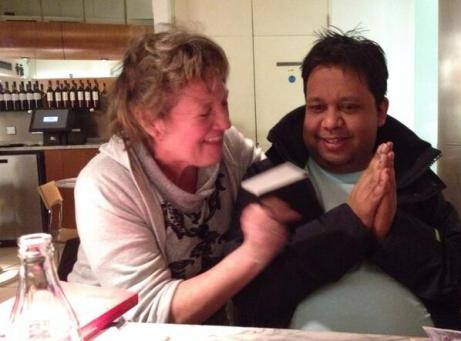Home » Posts tagged 'Dr Shibley Rahman'
Tag Archives: Dr Shibley Rahman
‘Reasons to be cheerful’ part 4. Prof Sube Banerjee’s inaugural lecture in Brighton on living well with dementia.
For me the talk was like a badly needed holiday. I joked with Kay there, a colleague of Lisa, that it felt like a (happy) wedding reception.
@charbhardy hello Chars – not at all the same without you. Thinking of you and G. Very windy on seafront here at Brighton x
— shibley (@legalaware) February 27, 2014
Unknown to me, the title of Prof Banerjee’s talk is an allusion to this famous track from 1979 (when I was five). It’s “Reasons to be cheerful (part 3)” by Ian Drury and the Blockheads.
The Inaugural Lecture – Professor Sube Banerjee (“Professor of Dementia”), ‘Dementia: Reasons to be cheerful’ was held on 26 February, 2014, 6:30 pm – 8:30 pm, at Chowen Lecture Theatre, Brighton and Sussex Medical School, Sussex Campus. BN1 9PX. Details are here on the BSMS website.
I found Prof Banerjee to be a very engaging, ‘natural’ speaker.
I arrived with hours to spare, like how the late Baroness Thatcher was alleged to have done in turning up for funerals.
Brighton are very lucky to have him.
But his lecture was stellar – very humble, yet given with huge gravitas. Banerjee is one of the best lecturers of any academic rank in dementia I have ever seen in person.
Banerjee started off with a suitable ‘icebreaker’ joke – but the audience wasn’t at all nervous, as they all immediately warmed to him very much.
He is ‘quite a catch’. He is able to explain the complicated issues about English dementia policy in a way that is both accurate and engaging. Also, I have every confidence in his ability to attract further research funding for his various teaching and clinical initiatives in dementia for the future.
Most of all, I was particularly pleased as the narrative which he gave of English dementia policy, with regards to wellbeing, was not only accurate, but also achievable yet ambitious.
1979 was of course a big year.
Prof Banerjee felt there were in fact many ‘reasons to be cheerful’, since Ian Drury’s remarkable track of 1979 (above), apparently issued on 20 July of that year.
Banerjee argued that the 1970s which had only given fruit to 209 papers, but things had improved ever since then.
It was the year of course Margaret Thatcher came to power on behalf of the Conservative Party.
In contrast, there have already been thousands of papers in the 2000s so far.
Banerjee also argued that “what we know is more likely to be true” which is possibly also true. However, I immediately reminisced of the famous paper in Science in 1982, “The cholinergic hypothesis of geriatric memory dysfunction”. This paper, many feel, lay the groundwork for the development of cholinesterase inhibitors such as donepezil (“Aricept”, fewer than twenty years later.
It is definitely true that ‘we are better at delineating the different forms of dementia’.
I prefer to talk of the value of people with dementia, but Banerjee presented the usual patter about the economic costs of dementia. Such stats almost invariably make it onto formal grant applications to do with dementia, to set the scene of this particular societal challenge.
I am of course a strong believer in this as my own PhD was in a new way to diagnose the behavioural variant of frontotemporal dementia. In this dementia, affecting mainly people in their 50s at onset, the behavioural and personality change noticed by friends and carers is quite marked. This is in contrast to a relative lack of memory of problems.
Not all dementias present with memory problems, and not all memory problems have a dementia as a root cause. I do happen to believe that this is still a major faultline in English dementia policy, which has repercussions of course for campaigns about ‘dementia awareness’.
A major drive in the national campaigns for England is targeted at destigmating persons with dementia, so that they are not subject to discrimination or prejudice.
The dementia friendship programmes have been particularly successful, and Banerjee correctly explained the global nature of the history of this initiative drive (from its “befriending” routes in Japan). Banerjee also gave an excellent example to do with language of dementia friendship in the elderly, which I had completely missed.
Raising awareness of memory problems in dementia is though phenomenally important, as Alzheimer’s disease is currently thought to be the most prevalent form of dementia worldwide.
The prevalence of dementia may even have been falling in England in the last few decades to the success prevention of cardiovascular disease in primary care.
The interesting epidemiological question is whether this should have happened anyway. Anyway, it is certainly good news for the vascular dementias potentially.
That dementia is more than simply a global public health matter is self-evident.
I’m extremely happy Banerjee made reference to a document WHO/Alzheimers Disease International have given me permission to quote in my own book.
Banerjee presented a slide on the phenomenally successful public awareness campaign about memory.
Nonetheless, Banerjee did speak later passionately about the development of the Croydon memory services model for improving quality of life for persons with mild to moderate dementia.
In developing his narrative about ‘living well with dementia’, Banerjee acknowledged at the outset that the person is what matters at dementia. He specifically said it’s about what a person can do rather than what he cannot do, which is in keeping to my entire philosophy about living well with dementia.
And how do we know if what we’re doing is of any help? Banerjee has been instrumental in producing, with his research teams, acceptable and validated methods for measuring quality of life in dementia.
The DEMQOL work has been extremely helpful here, and I’m happy Banerjee made a point of signposting this interesting area of ongoing practice-oriented research work.
Banerjee of course did refer to “the usual suspects” – i.e. things you would have expected him to have spoken about, such as the National Dementia Strategy (2009) which he was instrumental in designing at the time: this strategy was called “Living well with dementia”.
“I’m showing you this slide BECAUSE I want YOU to realise it IS complicated”, mused Banerjee at the objectives of the current English dementia policy.
I asked Banerjee what he felt the appropriate ‘ingredients’ of the new strategy for dementia might be – how he would reconcile the balance between ‘cure’ and ‘care’ – “and of course, the answer is both”, he said to me wryly.
Banerjee acknowledged, which I was massively pleased about, the current ‘barriers to care’ in this jurisdiction (including the known issues about the “timely diagnosis of dementia”.
Clearly the provision at the acute end of dementia care is going to have to come under greater scrutiny.
I increasingly have felt distinctly underwhelmed by the “medical model”, and in particular the repercussions of this medicalisation of dementia as to how grassroots supporters attempt to raise monies for dementia.
That certain antidepressants can have a lack of effect in dementia – Banerjee’s work – worries me.
That antipsychotics can have a dangerous and destructive effect for persons with dementia – also Banerjee’s work – also clearly worries me.
I am of course very proud that Prof Alistair Burns is currently reading my book focused on the interaction between the person and the environment in dementia.
And of course I’m ecstatic that Lisa Rodrigues and Prof Sube Banerjee signed my book : a real honour for me.
I signed Lisa’s book which was most likely not as exciting for her! X
Tour de force #ProfSubeBanerjee inaugural lecture made extra special by presence of @legalaware #reasonstobecheerful pic.twitter.com/qRpWReZOt0
— Lisa Rodrigues (@LisaSaysThis) February 26, 2014
There was a great atmosphere afterwards: the little chocolate brownies were outstanding!
Being an antisocial bastard, I didn’t mingle.
BUT I had a brilliant chat with Lucy Jane Marsters (@lucyjmarsters) who gave me a little bag of ‘Dementia is my business’ badges, very thoughtfully.
We both spoke about Charmaine Hardy. Charmaine was missed (and was at home, devoted to G.)
I’ve always felt that Charmaine is a top member of our community.
@legalaware oh Shibley how did you enjoy it? I wish I could have been there but it’s not possible to leave G anymore. Good being by the sea.
— Charmaine Hardy (@charbhardy) February 27, 2014
This apparently is a ‘Delphinium’.
A reason not to be cheerful was leaving Brighton, for many personal reasons for me.
Not even the Shard was a ‘reason to be cheerful’, particularly.
@legalaware @lucyjmarsters Come back soon, missing you already!!!
— Lisa Rodrigues (@LisaSaysThis) February 27, 2014
But when I came back, I found out that ‘Living well with dementia’ is to be a core part of the new English dementia policy.
Good to see ‘Living well with dementia’ will be a core part of England’s new dementia strategy 14-19 http://t.co/4rknTTzvl9 @nursingtimesed
— Living Well Dementia (@dementia_2014) February 27, 2014
I have, of course, just published a whole book about it.
The photograph of the poppy was of course taken by Charmaine Hardy: I have such great feedback on that one poppy in particular!
And what does the future hold?
Over to Prof Banerjee…
My book launch of “Living well with dementia” – special guest messages from Peter, Kate and Norman
I held a private book launch for guests of mine, who are interested in dementia at the grassroots level.
The talk was dedicated to Charmaine Hardy (@CharBHardy), whose husband has a very rare type of dementia known as primary progressive non-fluent aphasia. The publishers picked her poppy to be the cover of my book.
This for me, as was later suggested, as the book itself is dedicated to the memory of my late father (who did not have dementia but had a severe back pain which severely limited his quality of life in his final years.)
A special mention to Thomas Whitelaw (@tommyNTour) – a true gentleman and a Scot (!)
It was wonderful to meet Darren (@MrDarrenGormley) for the first time. Darren’s clearly someone who sees the person; with superb empathy skills, Darren and colleagues will need to be the change catalysts to break down obstructive silos.
It was a massive honour Beth Britton (@BethyB1886) could make it. Beth, like many in the room, of course knows this subject inside-and-out, and I am personally grateful to Beth for campaigning for the use and validation of more effective assessment of wellbeing approaches.
Here are some happy photos of my book launch.
I really couldn’t have been happier.
I am strongly against promoting my thesis about wellbeing with involvement of people as marketing ‘window dressing’
On the other hand, it gives me enormous pride to present to you the video presentations recorded by Norman McNamara, Kate Swaffer and Dr Peter Gordon which I played to my guests at the Arlington Centre in Camden on Saturday.
Friends of mine, who happen to be currently living with dementia, are also reading the book.
I mention during my presentations the ‘Purple Angels’, including Lynette Richards, Julie Line, Kim Pennock, Jane Moore, and of course Norman McNamara.
And no I am not a retainer from Ostrich Care! x
I feel it would have been it would have been “defeating the object”, if the book could not be read by people living lives with dementia.
Dr Peter Gordon is the only one of the three who does not have a dementia. He is a Consultant Psychiatrist working in this field. It was incredibly nice of him to put together his film for me, shown below.
Kate Swaffer (@KateSwaffer)
Norman McNamara (@norrms)
Dr Peter Gordon (@peterDLROW)
Living Well with Dementia from omphalos on Vimeo
Contents
Dedication • Acknowledgements • Foreword by Professor John Hodges • Foreword by Sally Ann Marciano • Foreword by Professor Facundo Manes • Introduction • What is ‘living well with dementia’? • Measuring living well with dementia • Socio-economic arguments for promoting living well with dementia • A public health perspective on living well in dementia, and the debate over screening • The relevance of the person for living well with dementia • Leisure activities and living well with dementia • Maintaining wellbeing in end-of-life care for living well with dementia • Living well with specific types of dementia: a cognitive neurology perspective • General activities which encourage wellbeing • Decision-making, capacity and advocacy in living well with dementia • Communication and living well with dementia • Home and ward design to promote living well with dementia • Assistive technology and living well with dementia • Ambient-assisted living well with dementia • The importance of built environments for living well with dementia • Dementia-friendly communities and living well with dementia • Conclusion
Sample chapter
The slides of the presentations
Reviews
Amazing … A truly unique and multi-faceted contribution. The whole book is infused with passion and the desire to make a difference to those living with dementia…A fantastic resource and user guide covering topics such as communication and living well with dementia, home and ward design, assisted technology, and built environments. Shibley should be congratulated for this unique synthesis of ideas and practice.’
Professor John R Hodges, in his Foreword
‘Outstanding…I am so excited about Shibley’s book. It is written in a language that is easy to read, and the book will appeal to a wide readership. He has tackled many of the big topics ‘head on’, and put the person living with dementia and their families at the centre of his writing. You can tell this book is written by someone who ‘understands’ dementia; someone who has seen its joy, but also felt the pain…Everyone should be allowed to live well with dementia for however long that may be, and, with this book, we can go some way to making this a reality for all.’ –Sally-Ann Marciano, in her Foreword
Extracts from my talks
This talk was given by me (Dr Shibley Rahman) on Saturday 15th February 2014 to a group of personally invited guests. Guests included persons with dementia, carers (past and present), campaigners, academics in social care, innovation and service provision, dementia club coordinators, and dementia nursing specialists.
1. This is the first segment of the first talk.
Particular things to look out for include:
James Murray-White (@sky_larking) 6 mins
Beth Britton (@BethyB1886) 7 mins
and their @AlzheimersBRACE work
Norman McNamara’s message at 15 mins
@mason4233 (Chris Roberts)’s tweet at 19 mins
2. I start off by thanking Prof John Hodges for his kind Foreword (0) and a clear description from Sally Marciano (@nursemaiden) why she, kindly, felt the book might be helpful. I am honoured at Sally’s personal contribution to my book.
I introduce the topic of personhood, using Tom Kitwood’s seminal work as a brief introduction only, but clearly the topic is huge. I then touch upon the practical difficulties academics and practitioners have had for their definitions of ‘living well’, and the implications therefore for its measurement.
There’s a clearly a debate to be had about why diagnosis might have been so problematic, using @edanaming’s research (Edana Minghella) as a springboard. At around 9’55”, I then use the problems in giving a potential diagnosis of dementia to a person is LGB or T as an illustration.
Gill Phillips (11′ 30″) kindly gives a brief description of the background and philosophy behind ‘Whose Shoes’, a modern application of personalisation which allows service users, including persons and patients with dementia, a say on what they wish to achieve from their person-centred care.
At around 16’30” Lucy Jane Masters (@lucyjmasters), a specialist nurse in dementia, explains the remarkably successful ‘Dementia is my business’ initiative, innovative badges which have acted as an ‘ice breaker’ for bringing about a cultural change in dementia care even amongst health professionals.
This next segment concludes with a brief discussion of the ethical issues of diagnosis, through Dr Peter Gordon’s contribution (@PeterDLROW). I use Peter’s letter to the BMJ as an introduction to the seminal four ethical principles of Beauchamp and Childress (1979), i.e. autonomy, beneficence, non-maleficence and justice. I also include Peter’s video which I will also separately upload elsewhere.
3. I then give an overview of some essential topics germane to this academic debate.
The contributions by the medics have not been a complete farce.
There’s been a lot of scrutiny about the ethical framework regarding dementia from people who are medically qualified, such as Dr Peter Gordon (@peterDLROW), Consultant in dementia. This was been necessary to neutralise some of the potent fraudulent memes in the media from elsewhere.
There’s been wonderful work too by @nchadborn on including service users’ views and opinions into the design of health services, from an applied perspective, as part of Nottingham University.
And the cognitive neurologists have been important in delineating the diverse cognitive presentations of dementia. Prof Facundo Manes’ group in Buenos Aires (@manesf) have been identifying how social cognition in the behavioural variant of frontotemporal dementia can be heavily dependent on context. As an example of this, I explain the Ebbinghaus Illusion and Titchener circles. Prof Manes is a colleague of ours in cognitive neurology, and wrote one of the Forewords to my book.
4. Particular things to look out for now include:
12″ Personal dedication to Charmaine Hardy [@CharBHardy] from England for the poppy on the front cover of my book, and being a key member of the #dementiachallengers
15″ The “Purple Angels” in raising dementia awareness and dementia friendly communities worldwide narrative. Jane Moore and Norman McNamara jointly designed this motif.
21″ beginning of the message by Kate Swaffer (@KateSwaffer), based in Adelaide, Australia, to my guests. (this is the beginning of the pre-recorded message; the second half of the message is in a different video.)
5. This last segment of my recordings contains the second part of Kate Swaffer’s message to my guests, and my film ‘Love is a wonderful thing’ for my community of delegates for the book launch.
The book
The book’s Amazon page, with some testimonials, is here.
The publishers’ page (Radcliffe Publishers) is here.
Independent blogposts by Gill Phillips (one of my guests) about my book launch at the Arlington Centre
These blogposts capture for me what was an extremely happy occasion for me.
‘Living well with dementia’ – the launch of Dr Shibley Rahman’s ground-breaking book
In the shoes of … | Dr Shibley Rahman. An intriguing and unique academic
Shibley Rahman Curriculum Vitae CV; and a kind tweet from the National Dementia Lead
I still think my biggest achievement ever was to overcome a severe alcohol dependence to start to lead a life in recovery. As of this day, I have had about 69 months in recovery. Of course my life was thrown upside-down when I had a cardiac arrest and epileptic seizure in June 2007, but successfully resuscitated by the medics in a North London hospital. I then spent six weeks in a coma. I couldn’t walk and talk at first, but thanks to intense rehabilitation at a different specialist unit in London I was able to learn how to walk and talk again. Whilst I have never had a regular salaried job ever for the last five years, I am very thankful that I am very content in recovery. I have since then been approved by the Solicitors Regulation Authority to do the Legal Practice Course, which I have now completed, and I indeed have now completed my Bachelor of Law, Master of Law and Master of Business Administration. I am currently writing my fourth book, this one being on wellbeing in dementia. My contribution to international dementia research is still considered to be seminal, and is indeed cited in the current Oxford Textbook of Medicine. This has recently been recognised in a very kind ‘tweet’ from the national clinical dementia lead, Prof Alistair Burns, here.
My current (public) CV is here.
Toxic cultures, NHS Trusts and the Francis Report.
Robert Francis has an incredibly difficult task. It is difficult for people who have not qualified in medicine, even managers and leaders of healthcare think tanks, to understand how this situation has arisen. Being a senior lawyer, his approach will necessarily involve “the law is not enough”. The NHS is currently a “political football”, but the overriding objective must be one of patient safety. Whatever your views about managers following financial targets religiously, and regulatory authorities pursuing their own targets sometimes with equal passion, it is hard to escape from the desire for a national framework for patient safety. This is at a time indeed when it is proposed that the National Health and Patient Safety Agency should be abolished, which indeed has oversight of medical devices and equipment. Indeed, one of the findings of the Francis Inquiry is that essential medical equipment was not always available or working. A general problem with the approach of the Health and Social Care Act (2012) has been the abolition of ‘national’ elements, such as abolition of the Health Protection Authority.
That the hospital assumes voluntarily a duty-of-care for its patient once the patient presents himself is a given in English law, but this fact is essential to establish that there has been a breach of duty-of-care legally later down the line. In the increasingly corporate nature of the NHS following the Health and Social Care Act, there is of course a mild irony that there is more than a stench of corporate scandals in the aftermath which is about to explode in English healthcare. Patients’ families feel that they have been failed, and this is a disgrace.
ENRON was a corporate scandal of equally monumental proportions, as explained here:
Mid Staffs NHS Foundation Trust was poor at identifying when things went wrong and managing risk. Some serious errors happened more than once and the trust had high levels of complaints compared with other trusts.
The starting point must be whether the current law is good enough. We have systems in place where complaints can be made against doctors, nurses, midwives and hospitals through the GMC, MWC and CQC respectively, further to local resolution. In fact, it is still noteworthy that many junior and senior doctors are not that cognisant of the local and national complaint mechanisms at all, and the mechanisms used for risk mitigation. There is a sense that the existing regulatory framework is failing patients, and public trust and confidence in medical and nursing, and this might be related to Prof Jarman’s suggestion of an imbalance between clinicians and managers in the NHS.
The Francis Inquiry heard a cornucopia of evidence about a diverse range of clinical patient safety issues, and indeed where early warnings were made but ignored. Prof Brian Jarman incredibly managed to encapsulate many of the single issues in a single tweet this morning:
Any list of failings makes grim reading. There are clear management failures. For example, assessing the priority of care for patients in accident and emergency (A&E) was routinely conducted by unqualified receptionists. There was often no experienced surgeon in the hospital after 9pm, with one recently qualified doctor responsible for covering all surgical patients and admitting up to 20 patients a night. A follower on my own Twitter thread who is in fact him/herself a junior, stated this morning to me that this problem had not gone away:
However, it is unclear what there may be about NHS culture where clinicians do not feel they are able to “whistle blow” about concerns. The “culture of fear” has been described previously, and was alive-and-well on my Twitter this morning:
Experience from other sectors and other jurisdictions is that the law clearly may not be protective towards employees who have genuine concerns which are in the “public interest”, and whose concerns are thereby suppressed in a “culture of bullying“. This breach of freedom of expression is indeed unlawful as a breach of human rights, and toxic leaders in other sectors are able to get away with this, in meeting their targets (in the case of ENRON increased profitability), “project a vision”, and exhibit “actions that “intimidate, demoralize (sic), demean and marginalize (sic)” others. Typically, employees are characterised as being of a vulnerable nature, and you can see how the NHS would be a great place for a toxic culture to thrive, as junior doctors and nurses are concerned about their appraisals and assessments for personal career success. “Projecting a vision” for a toxic hospital manager might mean performing well on efficiency targets, which of course might be the mandate of the government at the time, even if patient safety goes down the pan. Managers simply move onto a different job, and often do not have to deal even with the reputational damage of their decisions. Efficiency savings of course might be secured by “job cuts” (another follower):
Another issue which is clearly that such few patients were given the drug warfarin to help prevent blood clots despite deep vein thrombosis being a major cause of death in patients following surgery. This is a fault in decision-making of doctors and nurses, as the early and late complications of any surgery are pass/fail topics of final professional exams. Another professional failing in regulation of the nurses is that nurses lacked training, including in some cases how to read cardiac monitors, which were sometimes turned off, or how to use intravenous pumps. This meant patients did not always get the correct medication. The extent to which managers ignored this issue is suggestive of wilful blindness. A collusion in failure between management and surgical teams is the finding that delays in operations were commonplace, especially for trauma patients at weekends; surgery might be delayed for four days in a row during which time patients would receive “nil by mouth” for most of the day.
Whether this toxic culture was isolated and unique to Mid Staffs, akin to how corporate failures were rather specialist in ENRON, is a question of importance. What is clear that there has been a fundamental mismatch between the status and perception of healthcare entities where certain individuals have “gamed” the situation. Alarmingly it has also been reported that the University Hospitals of Morecambe Bay NHS Foundation Trust have also had a spate of failures in in maternity, A&E and general medical services. The Sarbanes-Oxley Act (2002) was enacted in the US in response to a number of high-profile accounting scandals. In English law, the Financial Markets and Services Act (2010), even during Labour’s “failure of regulation” was drafted to fill a void in financial regulation. There is now a clear drive for someone to take control, in a manner of crisis leadership in response to natural disasters. Any lack of leadership, including an ability to diagnose the crisis at hand and respond in a timely and appropriate fashion, against the backdrop of a £2bn reorganisation of the NHS, are likely to constitute “barriers-to-improvement” in the NHS.
This issue is far too important for the NHS to become a case for privatisation. It is a test of the mettle of politicians to be able to cope with this. They may have to legislate on this issue, but David Cameron has shown that he is resistant to legislate even after equally lengthy reports (such as the Leveson Inquiry). It is likely that a National Patient Safety Act which puts on a statutory footing a statutory duty for all patients treated in the NHS, even if they are seen by private contractors using the NHS logo, may be entitled to a formal statutory footing. The footing could be to avoid “failure” where “failure” is avoiding harm (non-maleficence). Company lawyers will note the irony of this being analogous to s.172 Companies Act (2006) obliging company directors to promote the “success” of a company, where “success” is defined in a limited way in improving shareholder dividend and profitability under existing common law.
The law needs to restore public trust and confidence in the nursing and healthcare professions, and the management upon which they depend. The problem is that the GMC and other regulatory bodies have limited sanctions, and the law has a limited repertoir including clinical negligence and corporate manslaughter with limited scope. At the end of the day, however, this is not a question about politics or the legal and medical professions, it is very much about real people.
The advantage of putting this on the statute books once-and-for-all is that it would send out a powerful signal that actions of clinical and management that meet targets but fail in patient safety have imposable sanctions. After America’s most high-profile corporate fraud trial, Mr Lay, the ENRON former chief executive was found guilty on 25 May on all six fraud and conspiracy charges that he faced. Many relatives and patients feel that what happened at Stafford was much worse as it affected real people rather than £££. However, the Sarbanes-Oxley Act made auditors culpable, and the actions of managers are no less important.
This is not actually about Jeremy Hunt. Warning: this is about to get very messy. That Mid Staffs is not isolated strongly suggests that an ability of managers and leaders in Trusts to game the system while failing significantly in patient safety, and the national policy which produced this merits attention, meaning also that urgent legislation is necessary to stem these foci of toxicity. A possible conclusion, but presumption of innocence is vital in English law, from Robert Francis, and he is indeed an eminent QC in regulatory law, is that certain managers were complicit in clinical negligence at their Trusts to improve managerial ratings, having rock bottom regard for actual clinical safety. This represents a form of wilful blindness (and Francis as an eminent regulatory QC may make that crucial link), and there is an element of denial and lack of insight by the clinical regulatory authorities in dealing with this issue, if at all, promptly to secure trust from relatives in the medical profession. The legal profession has a chance now to remedy that, but only if the legislature enable this. But this will be difficult.
Tomorrow's hymns for the Royal Wedding
Love divine, all loves excelling
Guide me thou O great redeemer
Jerusalem
Results of the "Second Life" survey
A common strand underlies much of what we do: the law, legal education and legal services. That is in real life. These days, technological developments are also driving fundamental changes in customer behaviour and expectations. This creates exciting opportunities for businesses that use such communications. It especially throws up the challenge of finding better ways of engaging with customers. Law schools and professional legal services firms are themselves businesses, are keen to position themselves in the market using such innovative advantages. This article is about the world of “SL” (SL), one very important contemporary example.
The LegalIncite “SL” Survey 2011
To get an overview of current attitudes to SL, a survey was advertised on the BPP VLE Blackboard (“the Survey”), Twitter and Facebook. There were 20 respondents in total; this article will refer to main findings from this small study where relevant. There was an even spread of ages from 16 to 63. 95% of these said they enjoy using computers, and 85% said they are good at using computers. However, only 26% said they would wish to join SL currently.
History
SL is an online virtual world developed by Linden Lab, which was launched on June 23, 2003. SL users, called Residents, interact with each other through avatars. Residents can explore the world (known as “the grid”), meet other residents, socialise, participate in individual and group activities, and even create and trade virtual property and services with one another. Since opening in 2003, “SL” has experienced strong growth. Now some 1.3 million people around the world log on to live out their second lives.

The economy
SL has an internal economy and internal currency, the Linden dollar (L$). L$ can be used to buy, sell, rent or trade land or goods and services with other users. Virtual goods include buildings, vehicles, devices of all kinds, animations, clothing, skin, hair, jewelry, flora and fauna, and works of art. Services include “camping”, wage labour, and business management. L$ can be purchased using US Dollars and other currencies on the LindeX exchange provided by Linden Lab, independent brokers or other resident users. Profits are derived from selling virtual goods, renting land, and a broad range of services. 84% in our survey said that they did not like this notion of real-life money being exchanged for L$.
Many argue that it is impossible to divorce SL from regulation. On July 26, 2007, Linden Lab announced a ban on “in-world gambling”, in fear that new regulations on Internet gambling could affect Linden Lab if it was permitted to continue. The ban was immediately met with in-world protests. 74% of respondents in our Survey felt there should be laws on gambling.

Law School
At Harvard, Charles Nesson, the Weld professor of law, is offering “CyberOne: Law in the Court of Public Opinion,” not only to Harvard Law School (HLS) students, but also to Extension School students as well as Internet users across the globe. Nesson drummed up interest in his ‘filled-to-capacity’ course through a YouTube promotional tape in which he describes its content after a dramatic entrance on a scooter. The tape is mostly narrated by his avatar, a significantly younger-looking SL persona. His daughter, Rebecca N. Nesson , a Harvard Law School graduate and Harvard computer science doctoral candidate who is co-teaching the course, also makes an appearance in the promo, saying, “in SL, the possibilities of what we can do are endless” as she, in fact, transforms into a butterfly.

Legal services
Across the pond, Field Fisher Waterhouse (FFW), which has a substantial media, technology and intellectual property service, has become the first major, international law firm in England to open an office in a virtual world. David Naylor is the FFW partner behind the initiative, and apparently found much support from FFW in investing in this project given its existing client-base; his avatar is “Solomon Cortes”.
The two-storey virtual office boasts the same meeting rooms, corporate art collection and giant presentation screens that can be found at any self-respecting City firm. It even includes a roof terrace with a water feature. Multi-national businesses such as Dell, Nike, Mercedes and Calvin Klein have sought to establish their brands in SL and David hopes that having a virtual presence will help attract them as clients in the “real world”.
Various corporates have already expanded their branding to virtual environments too. Nike has a virtual clothing store, and car manufacturers such as Nissan, Pontiac and Toyota have entered SL. There are even businesses that specialize in launching and integrating real-world brands into the virtual world
SL is not yet sufficiently developed for a debate to have taken place over which, if any, legal jurisdiction applies. However, David insists that, with real business being carried out and real money changing hands albeit in SL’s own virtual currency, companies operating there need legal advice. So far the list of businesses operating in the virtual world is not limited to standard retailers with a tangible product to sell. Professional advisers such as ABN Amro, Accenture and PA Consulting have already established a presence and rumours are circulating that several accountancy firms are planning similar moves.
In addition to attracting new clients and winning publicity for the firm, David believes his new office can be used to help existing clients and staff by hosting virtual seminars, conferences and training days. It will also be a useful recruitment tool in the increasingly competitive market for young legal talent. Like real life, there is a close relationship emerging between legal education and professional legal services.
The Law
An impressive 79% in our Survey felt that SL needed some sort of regulation, but a smaller proportion (63%) believed there should be a ‘comprehensive set of laws’.
It is estimated that each day in excess of $1 million USD worth of transactions take place in SL. Therefore, it is no surprise that the virtual economy of SL has resulted in trademark and copyright infringement lawsuits being brought in U.S. courts. In a lawsuit filed on October 24, 2007 in the Eastern District of New York, a group of virtual merchants selling virtual products in SL sued Thomas Simon. The virtual merchant appellants claimed that Simon willfully made unauthorised copies of their copyright and trademark protected products, and Simon misrepresented that the products he sells are authentic ones. The appellants sold adult-themed virtual items, including furniture, shoes, and skins to cover the avatars. The complaint included claims of unfair competition under Section 43(a) of the Lanham Act, copyright infringement under the U.S. Copyright Act, and counterfeiting of a registered trademark. This case settled in December 2007.
Bragg v Linden Labs (2007)
Indeed, real life can meet the virtual world of SL. In 2006, Pennsylvania lawyer Marc Bragg (“Marc Woebegone” in SL) brought a lawsuit against Linden Lab, when his account was unilaterally disabled by SL administrators. Linden Lab claimed that Marc Bragg had violated their Terns of Service by URL-hacking the SL virtual land auction website in order to gain access to otherwise unavailable auctions. As a result, Bragg was able to purchase virtual land within SL valued at $1,000 for approximately $300. Bragg’s account was suspended while Linden Lab conducted an investigation, and later closed completely. Bragg argued that by closing his account, Linden Lab also dissolved his virtual assets, which he valued at between US$4,000 and US$6,000.
This case was particularly interesting as the Court held an arbitration clause within Linden Lab’s Terms of Service – a web-based ‘clickwrap’ agreement – to be invalid. The clause was held to be unconscionable as there was no room for negotiation, the clause was inconspicuously printed, and since no other virtual world offered ownership rights, Bragg was deemed to have no alternative market choice. Additionally, the arbitration procedure was deemed too expensive to offer Bragg any realistic recourse for disputing Linden Lab’s actions. However, overall, ss proceedings continued to advance, perhaps the most interesting aspect of this case to date has been the Court’s willingness to engage with the concept of virtual property rights.
Conclusion
In less than a decade, a virtual world has evolved at a staggeringly fast rate. In this time, businesses for products and services have evolved, but so also has the scope for problems. Like real life, the law has developed to try to solve these problems, and it may be getting to the stage now where it can begin to anticipate new problems. It remains to be seen whether a set of comprehensive laws will develops, and what jurisdiction these laws will have, or whether the law will progress on a case-by-case basis as a judge-made law. Whatever the exact mode of evolution, innovative and talented lawyers will be especially keen to follow the progress of SL, in its effect on the law, legal education and legal services.
It's hurting but it isn't working – Ed Miliband's brilliant response
Ed Miliband’s speech was brilliant with this incredible ad lib:
“George Osborne at the weekend aspired to be a mix of Nigel Lawson and Michael Heseltine, with typical Conservative hubris. He’s more like Norman Lamont with an iPod playing ‘Je Ne Regrette Rien'”.
Remember this?

Well, this is the text of today’s response by the Leader of the Opposition, Ed Miliband, to the Chancellor of the Exchequer announcing his UK budget for 2011.
Mr Deputy Speaker, the Chancellor spoke for nearly an hour.
But one fact says it all.
Growth down last year, this year and next year.
It is the same old Tories.
It’s hurting but it isn’t working.
What did he say last year about growth?
Judge me on the figures.
Well judge him we will.
Every time he comes to this House, growth is downgraded.
Last June, 2011 growth down from 2.6% to 2.3%.
In November, down again.
In January what did the Prime Minister say?
His three priorities for this year were growth, growth, growth.
And what happened?
Growth is down, down, down.
And taking account of all the measures.
What is the Chancellor’s singular achievement?
To deliver a budget for growth that downgrades the growth forecasts.
Down this year to 1.7%.
Downgraded next year too.
It didn’t happen by chance.
It happened by choice.
His choice.
And it’s the wrong choice.
To go too far and too fast.
There was another way.
In his own words from the June Budget – he chose to go £40bn further and faster in tax rises and spending cuts than our plan to halve the deficit over four years.
It’s the pace of cuts that has seen consumer confidence fall in almost every month since the General Election.
In his first Budget the Chancellor promised:
“steady and sustained economic recovery”.
And when last September’s growth figures came out, the Chancellor took the credit.
He called the figures “a vote of confidence” in the Government’s economic policy.
But when the economy contracted in the fourth quarter, what did he do?
He blamed the snow.
Mr Deputy Speaker, even he must appreciate the irony.
Because while the Prime Minister was grounded from his Christmas trip to Thailand, the Chancellor was on the piste in Klosters.
Mr Deputy Speaker, I guess it was the right type of snow for a skiing holiday.
Just the wrong kind of snow for our economy.
But what is it about the British snow?
They had worse snow in Germany…
…a big freeze in France…
… in the US – the worst blizzards for decades.
But despite all of that their economies grew in the fourth quarter.
And while our growth forecasts have worsened, theirs have improved.
The German economy is forecast to grow more strongly than it was last year.
So is the US.
Growth in the world economy has been revised up.
But which is the ma jor country downgrading its growth forecasts?
The United Kingdom.
It’s not the wrong type of snow that’s to blame, Mr Deputy Speaker.
It’s the wrong type of Chancellor,
…the wrong type of chancellor, in the wrong type of government
With the wrong priorities for Britain.
He also promised in June that his Budget would deliver “low inflation”
And what has happened?
Inflation has risen month after month after month.
It didn’t simply happen by accident.
It is happening because he took the wrong decision on VAT.
Same old taxes.
Same old Tories.
And he promised us falling unemployment too.
And what has happened since he gave his first Budget?
Over 60,000 more people looking for work.
And today we are told in the Red Book unemployment is forecast to rise further.
To this Tory Government, just like the ones of the past, unemployment is still a price worth paying.
And many people will wonder what world the Chancellor was describing today.
In the constituencies of over 130 Members of this House, 10 people are chasing every job.
One in five young people looking for work.
Communities seeing libraries and children centres closing.
Families seeing their living standards squeezed.
Not just this year, but year after year after year.
And what does the Government say to communities losing jobs?
Let me tell you what they recently told the people of Newport, justifying the closure of their passport office.
It said the redundancy payments of the staff being sacked would provide a “boost in trade for the local economy”.
What kind of planet are these people living on?
On growth, on inflation, on unemployment – on the promises he made, the Chancellor couldn’t bring himself to admit the truth.
That his second Budget tells the story of the failure of his first.
At this stage of the recovery growth should be powering ahead.
Unemployment should be falling fast.
And every month when unemployment is higher than it should be it stores up long-term damage.
Every month when growth is lower than it should be, it hits the future potential of our economy.
The problem is, instead of admitting it, he refuses to change course.
What did the Energy Secretary say?
If the figures change the Government “should not be lashed to the mast” of their reckless gamble.
It should be willing to change and think again.
Mr Deputy Speaker, it’s not as if they haven’t had practice at the u-turn business.
They’re becoming the past masters.
On forests, school sport, housing benefit for those looking for work, even on the vanity photographer, they have been forced to climb-down.
But on this, the issue that matters most, they are least willing to change.
At the weekend we learned something new about the Chancellor:
Apparently, his political aspiration is to be a blend of Nigel Lawson and Michael Heseltine.
Mr Deputy Speaker, another comparison springs to mind.
Because we see the same refusal to change course we saw from the Tories in the early 1980s.
The same hubris and arrogance of the early 1990s.
He’s more like the political love child of Geoffrey Howe and Norman Lamont.
Next thing we know, he’ll be ordering in the champagne and singing in the bath, je ne regrette rien.
Mr Deputy Speaker, this is not a growth Budget.
It is not a jobs Budget.
It is a Budget for more of the same.
From a complacent, arrogant Chancellor.
In a complacent, arrogant Government.
It’s hurting but it isn’t working.
Mr Deputy Speaker, let us not forget, these are not just the Chancellor’s decisions.
They are not just the Prime Minister’s decisions.
They’re the Deputy Prime Minister’s decisions too.
He is an accomplice to this Tory plan.
When it comes to the economy, the man who coined the phrase alarm clock Britain has the snooze button well and truly on.
Nobody voted for this deficit plan.
Least of all his Liberal Democrat voters who were told in promise after promise that he would never countenance it.
Mr Deputy Speaker, if I can put it this way, is it any wonder no-one wants to share a platform with him.
On the measures he proposes to support growth, we will look at them.
But there is little reason to believe they will make the difference to growth we need.
The Office for Budget Responsibility has already factored in every single measure he’s just announced.
And they still produced today’s downgraded growth forecast and higher unemployment figures.
And it’s no wonder.
An enterprise zone proposal dusted off from the 1980s cannot undo the damage of a deficit plan that goes too far and too fast.
It didn’t work then, it won’t work now.
And you can’t blame people for being sceptical when the Chancellor says he’s got a new flagship policy for growth.
Because what happened to his last flagship policy for growth, at the centre of his June Budget?
Does anyone remember the national insurance holiday
He was strangely silent about it today.
In June he boasted it would help to protect the areas worst hit by his cuts.
He stood at that despatch box taking credit for the 400,000 small firms he said would benefit.
How many have actually benefitted?
Mr Deputy Speaker, he’s been strangely shy in revealing the figures but someone let slip to the Financial Times.
By mid-January it wasn’t 400,000.
It wasn’t 40,000.
It wasn’t even 4,000.
It was less than a half of one percent of the number he prom ised, just 1,500 businesses.
And his green flagship policy, the Green Investment Bank.
I think his energy Secretary had it spot on.
“Ducks quack, and banks borrow as well as lend.”
Well his green bank can’t borrow for the next 5 years.
And this policy is a lame duck.
On his incentives for small firms, we will look at the detail
But I have to say, his decision to cancel flexible working for families with children between 16 and 18 is extraordinary.
Only this Prime Minister could take the credit for championing a policy with Mumsnet, and then a few months later take the credit with small business for dumping it.
You’ve got to ask Mr Deputy Speaker – has he no shame?
The idea that families needing flexibility imperil our economic future is frankly absurd.
And tells you all you need to know about this Government’s values and how they think our economy succeeds.
Greater insecurity as t he route to greater prosperity.
Well we take a different view.
Flexible working is yet another broken promise from the broken promise Prime Minister.And while we’re on the subject what about one of the biggest broken promises of all.
Remember what he said before the election?
He, the Prime Minister, was banker basher in chief.
He was the man to deliver, and I quote, a day of reckoning for the bankers.
It’s not a day of reckoning, it’s business as usual.
Last year Labour’s bonus tax raised £3.5bn.
And this year their bank levy raises just £1.9bn.
A Tory Government cutting taxes for the banks.
Instead of doing that he should have used the money to reintroduce the Future Jobs Fund, build 25,000 homes, and boost enterprise.
They are not taking the long term steps to build the high skill, high wage economy of the future.
Mr Deputy Speaker, they are failing on growth, and they are failing on living standards too.
What did the Prime Minister say before the election to families receiving tax credits?
He said that below £50,000 a year, their tax credits were safe
When Labour said otherwise, the Home Secretary said this:
“That is a lie, and it is irresponsible for Labour to be … worrying families needlessly”.
But what is the truth?
Next year, over one million families with incomes as low as £26,000 will lose all their tax credits.
They should be ashamed of their broken promises.
All part of the cost of living crisis they are imposing.
The Chancellor trumpeted the rise in the personal allowance.
But let’s look at the facts.
He came along in the June Budget and put up VAT, costing families £450 a year.
Now he’s got the nerve to expect them to be grateful when he gives them a fraction of their own money back.
Let me tell you what the Institute for Fiscal Studies told us this morning: “there is an awful lot of giving with one hand… and taking away with lots and lots of other hands.”
It’s the classic Tory con.
And what about their decision on petrol?
He’s done the same thing again.
He’s cut duty by 1 pence.
But he’s whacked up VAT on fuel by 3p.
Families won’t be fooled.
It’s Del Boy economics.
For a two earner family both on average wages, after VAT and tax credits, it’s the same as 5p up in the basic rate of income tax this year and just 1p down next.
What do the British people know from history?
Every Tory tax cut ends up costing them more.
Same old Tories.
Same old deceit.
We needed a Budget that changed the direction of economic policy.
We needed a Budget that protected the Promise of Britain that the next generation does better than the last.
We needed a Budget that changed course on cutting too far and too fast.
The Chancellor said at the weekend with his customary modesty that he had completed his rescue mission of the British economy.
After this Budget, it’s not the Chancellor who is rescuing the country.
It is the country that needs rescuing from the Chancellor.
Mr Deputy Speaker, when families look at this Budget,
Look at the squeeze on their living standards,
Look at the job losses in their communities,
They will conclude:
It’s hurting but it isn’t working.
The budget
I have a terrific regard for the University of Oxford and the PPE course (Politics, Philosophy and Economics).
As an educationalist, I think it is a very clever combination of three subjects taught to a hugh standard by three separate examination schools. However, as a neuroscientist, I think the subject is ahead of its time. For me, it represents whether the markets operate with free will or deterministically, and whether its expedient for governments to make decisions around such findings, inter alia. And the list of PPE graduates is a wonder to behold: Andreas Whittam-Smith, Guto Harri, Mary Ann Sieghart, Nick Cohen, Nick Robinson; and of course, Stephanie Flanders, Hugh Pym and Ed Balls. I was disappointed, but not particularly surprised, to see George Osborne not on this list.

With the ritualistic nature of the Budget, it is easy to forget that the budget for any business entity represents the pivotal focus of budgeting (as the name would imply) and forecasting. This is interesting in the context of the overall business strategy, and provides an important exercise for seeing the progress of the organisation with its economic goals. In summary, we saw inflation go up to 4.4% yesterday, GDP is going down (although hopefully it is likely we will avoid a ‘double dip’ of two quarters of negative growth seeing us back into recession), unemployment rising particularly youth unemployment, and interest rates probably about to go up. The danger with the cuts strategy, of cutting quite so much fast so fast, was that we would risk slow growth, with people being laid off in the public sector with the private sector not picking up the slack, as the Tory-led government had hoped. This would mean there would be less spending power, more unemployment benefit being paid, less tax revenue, and the deficit actually not being cut as fast as desirable. It is also incredibly depressing for morale. Many of us have felt that even if the deficit is paid off fast the wreckage that would be produced socially would be difficult to recover from. Hence, we at Cambridge, have a somewhat different emphasis. We don’t call it “Politics, Philosophy and Economics”, but “Social and Political Sciences”. You’ll see this perhaps this Saturday…
The May Elections and a conservative outcome
Of course, I’ve heard the speak about how we live in a country, England, that is fundamentally left. I am not convinced. I still believe that, as a country, we’re very conservative, with the small ‘c’. Not ‘C’ for the other word I commonly encounter in relation to the coalition’s cuts on Facebook.
The implications of this for May 6th are pretty straight-forward. We go from a position where people were voting to keep Cameron out to a position where people vote to keep Clegg out. A vast majority of people feel that Nick Clegg has been utterly useless in government in voicing any concerns about EMA, tuition fees, and a vast gamut of themes. Therefore, they simply won’t vote for anything that remotely represents him. This could mean that people will vote Conservative or Labour, according to what will achieve that aim. I do not feel that there is widespread hatred to the cuts, as there is possibly towards the tuition fees. There is an unspoken sense that many members of the general public do appreciate the argument that it’s unwise to spend £120 million/day on interest. I would not be surprised if the Conservatives actually do rather well in the elections. It is not impossible that, with the current electoral system, they could even win. There is, of course, a huge number of people who oppose the rate and depth of the cuts, but they might find the odds voting against the sitting government heavily stacked against them.
And what does being conservative mean for the AV vote? Well, in this new breaking pledge era, Labour’s previous commitment to it is not that important. It does mean, however, people might vote in favour of keeping the status quo, particularly if it means that the second choice doesn’t come out as victorious (a Nick Clegg clone), or if they simply don’t understand the new system. If the country votes ‘No’ for AV, it might be seen as a tacit indorsement for David Cameron, but it will be difficult to ignore the impact this has on Nick Clegg. No matter how hard the spin doctors tell us to keep the issues separate.




